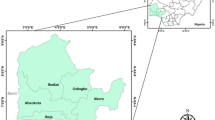Abstract
The concept of effective temperature appears to have certain advantages for indoor use and is applied as an example to the climatological data for Alice Springs, Australia. Average values of effective temperature for the hottest hour of the day are compared with those for certain Australian and overseas locations and it is concluded that, although Alice Springs is uncomfortable for a substantial part of the warm season, the climate is more comfortable than the tropical north of Australia and some overseas arid areas. The larger diurnal range at Alice Springs means more comfortable nights than in areas near the tropical coast. It is stressed that mean values can be misleading, and for adequate treatment it is necessary to examine the distribution of daily values.
Zusammenfassung
Das Konzept der effektiven Temperatur scheint gewisse Vorteile für die Anwendung im geschlossenen Raum zu besitzen und wird als Beispiel für die klimatologischen Daten von Alice Springs angewandt. Durchschnittswerte der effektiven Temperatur für die heisseste Stunde des Tages werden mit denen für bestimmte australische und überseeische Orte verglichen.Es wird gefolgert,dass,obwohl Alice Springs für einen bestimmten Teil der warmen Jahreszeit ein unbekömmliches Milieu hat, das Klima trotzdem bekömmlicher ist als der tropische Norden Australiens und einige aride Gebiete in Übersee. Die grössere Tagesschwankung in Alice Springs ist gleichbedeutend mit bekömmlicheren Nächten, als sie in den Gebieten nahe der tropischen Küste vorhanden sind. Es muss gefolgert werden, dass Mittelwerte zu falschen Deutungen führen und dass es für einen genauen Vergleich notwendig ist,die Verteilung der täglichen Werte hinzuzuziehen.
Resume
Le concept de la température effective semble présenter certains avantages pour caractériser le climat intérieur des habitations. Il est appliqué ici par exemple aux données climatologiques d'Alice Springs (Australie). On compare des valeurs moyennes de la température effective des heures les plus chaudes de la journée avec des valeurs similaires provenant d'autres lieux d'Australie ou d'ailleurs. On en conclut bien qu'à Alice Springs le climat soit peu propice durant une bonne partie de la saison chaude; mais il est, en général, moins éprouvant que dans le nord tropical de l'Australie ou que dans des régions arides d'autres continents. La grande variation diurne que l'on observe à Alice Springs rend les nuits plus supportables que dans le voisinage de la côte tropicale. Il faut en conclure que les valeurs moyennes peuvent conduir à de fausses interprêtations et que, pour établir des comparaisons valables, il faut tenir compte aussi de la répartition des valeurs journalières.
Similar content being viewed by others
References
AMERICAN SOCIETY OF HEATING, REFRIGERATING AND AIR CONDITIONING ENGINEERS (1960): Heating, Ventilating and Air Conditioning Guide.Amer.Soc. Heat.Air Cond.Eng., Washington, D.C. Chapter 6. Physiological Principles, 38: 63–74.
BELDING, H.S. and HATCH, T.F. (1955): Index for evaluating heat stress in forms of resulting physiological strains.Heat.Piping Air Condit., 27: 129–136.
HOUGHTEN, F.C. and YAGLOGLOU, C.P. (1923): Determining lines of equal comfort. J.Amer.Soc.Heat.Vent.Eng., 29: 165–176.
LEE, D.H.K. (1958): Proprioclimates of man and domestic animals. Australia — Unesco Symp. Canberra, 1956. Climatology and Microclimatology. Arid Zone Res. (Unesco), 10: 102–125.
LEE, D.H.K. and HENSCHEL, A. (1963): Evaluation of thermal environment in shelters. Techn.Rep. 8, U.S. Dept. of Health, Education and Welfare. Division of Occupational Health, Cincinnati, Ohio, p. 58.
SEIFERT, Gerda (1958): Das Klima der DDR — dargestellt durch Effektiv-temperaturen. Z.Meteor., 12: 328–338.
THOM, E.C. (1959): The discomfort index. Weatherwise, 12: 57–60.
Author information
Authors and Affiliations
Rights and permissions
About this article
Cite this article
Hounam, C.E. Meteorological factors affecting physical comfort (with special reference to Alice Springs, Australia). Int J Biometeorol 11, 151–162 (1967). https://doi.org/10.1007/BF01426842
Received:
Issue Date:
DOI: https://doi.org/10.1007/BF01426842




